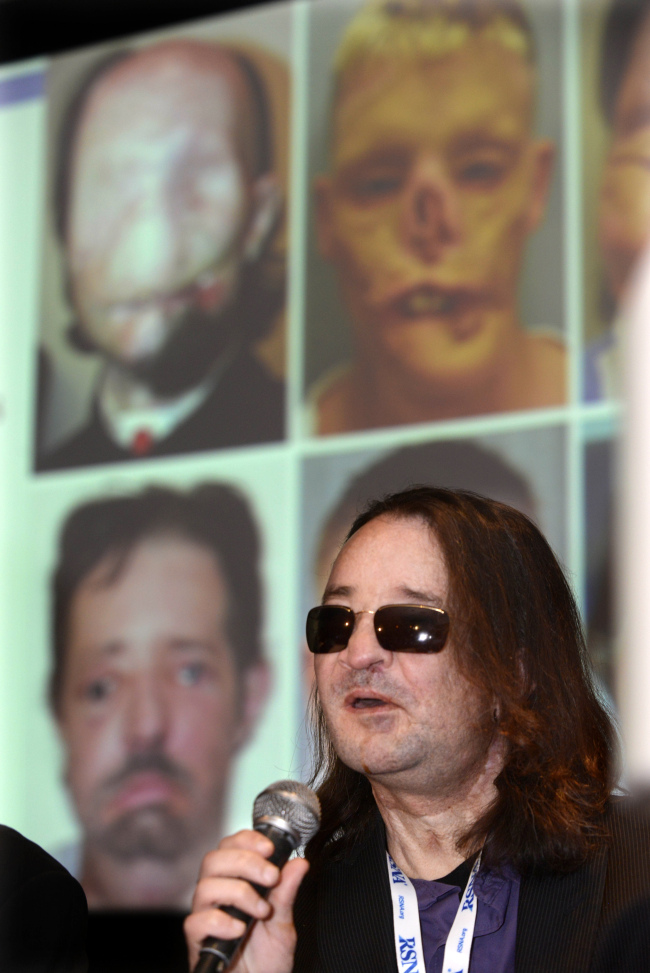CHICAGO (AP) ― The nation’s first full face transplant patients are growing into their new appearances ― literally.
Medical imaging shows new blood vessel networks have formed, connecting transplanted skin with the patients’ facial tissue, a finding that may help improve future face transplant surgeries, doctors announced Wednesday.
Dallas Wiens, the first U.S. man to get a full face transplant, is a remarkable example of that success. The 28-year-old Fort Worth man attended Wednesday’s annual meeting of the Radiological Society of North America with his new wife and golden retriever guide dog. Despite still-visible facial scars from the March 2011 surgery, he looks and sounds like a recovered man.
“My entire life is a miracle,” Wiens said at a news conference.
 |
Dallas Wiens, the first full face transplant patient in the U.S., speaks during a news conference at McCormick Place in Chicago, Wednesday. (AP) |
His face was burned off in a 2008 painting accident at his church. He was on a cherry-picker lift when his head hit a high voltage wire.
After surgery, Wiens lived for two years with no facial features and just a two-inch slit for a mouth, until his transplant at Boston’s Brigham and Women’s Hospital.
Imaging studies on Wiens and two other full face transplants done at Brigham in 2011 show that a network of new blood vessels had formed just a year after the operations. A fourth full face transplant was performed at Brigham earlier this year.
The same thing typically happens with other transplants and it helps ensure their success by boosting blood flow to the donor tissue. But Brigham doctors say this is the first time it has happened with full face transplants.
The finding could eventually shorten the operating time for future face transplants, Brigham radiologist Dr. Frank Rybicki said. The operations can take up to 30 hours and include attaching spaghetti-thin arteries in the patients’ existing tissue to the donor face, but the findings suggest attaching only two facial or neck arteries instead of several is sufficient, he said.
Dr. Samir Mardini, a Mayo Clinic expert in reconstructive transplant surgery, said blood vessel reorganization occurs with other types of tissue transplants ― doctors call it “neovascularization” and it helps ensure the tissue’s survival by improving blood flow.
“It’s interesting that they’ve shown it” with face transplants, but it’s not a surprise, Mardini said.
Face transplants, using cadaver donors, are still experimental. Fewer than 30 have been done since the first in 2005, said Dr. Branko Bojovich, a surgeon involved in a 2012 face transplant at the University of Maryland Medical Center.
He called the Boston team’s findings “very reassuring” for surgeons and for future patients.
“We’re assuming that these patients will hopefully go on to live productive and long lives,” Bojovich said.
Wiens’s life before the accident was troubled, and he says he misses nothing about it except possibly his eyesight.
“I’ve learned more about other people and myself, being blind,” he said.
He met his wife, Jamie Nash, in a support group for burn patients, and they were married in March at the same church where Wiens’s accident occurred. That was a symbolic choice, Wiens said.
“The most life-changing experience I had happened at that church. I felt like the beginning of my new life should happen there,” he said.
Nash, 30, had suffered severe burns in a 2010 car crash in which she lost control of her car while texting.
The couple lives with his 6-year-old daughter and her two children. Nash helps him “see” and he helps her do things that are difficult because of her scarred, stiff arms.
Together, they work with a foundation Nash set up to advocate against texting and driving, visiting schools to bring the message to teens. Wiens says the work helps make his new life fulfilling.
The nation’s first full face transplant patient Dallas Wiens briefly takes his sunglasses off af …“Our life is incredible,” Nash said Wednesday. “We are so much in love.”
Added Wiens, “There is life after tragedy.”





![[Herald Interview] 'Trump will use tariffs as first line of defense for American manufacturing'](http://res.heraldm.com/phpwas/restmb_idxmake.php?idx=644&simg=/content/image/2024/11/26/20241126050017_0.jpg)


